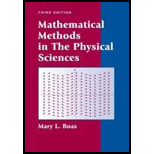
Concept explainers
Use the convolution integral to find the inverse transforms of:
Want to see the full answer?
Check out a sample textbook solution
Chapter 8 Solutions
Mathematical Methods in the Physical Sciences
Additional Math Textbook Solutions
Elementary Statistics: Picturing the World (7th Edition)
A Problem Solving Approach To Mathematics For Elementary School Teachers (13th Edition)
Calculus: Early Transcendentals (2nd Edition)
- Prove 11.1.2arrow_forward24.4. For the function g(z) defined in (18.7), show that g(z) = j=0 z2j (−1)³ (2j+1)!" Hence, deduce that the function g(z) is entire. 2 E C.arrow_forward39. (a) Show that Σeak converges for each α > 0. (b) Show that keak converges for each a > 0. k=0 (c) Show that, more generally, Σk"eak converges for each k=0 nonnegative integer n and each a > 0.arrow_forward
- #3 Find the derivative y' = of the following functions, using the derivative rules: dx a) y-Cos 6x b) y=x-Sin4x c) y=x-Cos3x d) y=x-R CD-X:-:TCH :D:D:D - Sin f) Sin(x²) (9) Tan (x³)arrow_forwardShow three different pairs of integers, a and b, where at least one example includes a negative integer.arrow_forwardShow three different pairs of integers, a and b, where at least one example includes a negative integer. For each of your examples, determine if each of the following statements are true or false:arrow_forward
 Linear Algebra: A Modern IntroductionAlgebraISBN:9781285463247Author:David PoolePublisher:Cengage Learning
Linear Algebra: A Modern IntroductionAlgebraISBN:9781285463247Author:David PoolePublisher:Cengage Learning
